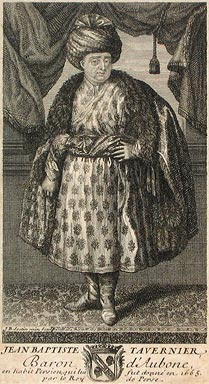Briolette History
The earliest recorded history of briolettes dates back to the 1600's. It was Tavernier during his epic travels to India who returned to Europe with briolette cut gems. Famous historic briolette owners included; Louis IV, Marie Antoinette, Henry Philip Hope ( Hope diamond ) and English royalty. Numerous ancient briolettes are amongst the prestigious Crown Jewels of Iran.

Jean-Baptiste Tavernier,
1605-1689.
During the 18th and early 19th centuries as technology and science progressed, many historic traditions fell by the wayside. Gem cutters were not immune from these "advances", abandoning historic cuts in favor of the precursors to the modern table-crown-pavilion cuts we see today. Traditional historic cut gemstones were recut to the new standards. Old cutting styles disappeared. An ancient art form was lost. Briolettes were amongst the casualties.
It wasn't until the Victorian and Art Deco periods that briolettes rose to prominence again, only to fade with the depression and post war years of the 20th century. Once again gems were being cut to new standards set in the diamond industry. Briolettes were viewed as an inefficient use of gem rough. They were a victim of "progress".
With the arrival of the millennium and renewed appreciation for history, briolette popularity is on the rise. Recently briolettes have been the subject of numerous articles in major industry publications, and incorporated into the jewelry of many well known designers. Their subtle beauty is proving to be timeless.
Steve Green
